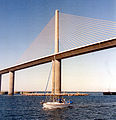
Tampa, Florida
Tampa (US: /ˈtæmpə/ TAM-pə) is a city on the Gulf Coast of the U.S. state of Florida. The city's borders include the north shore of Tampa Bay and the east shore of Old Tampa Bay. Tampa is the largest city in the Tampa Bay area and the seat of Hillsborough County. With an estimated population of 398,173 in 2022, Tampa is the 49th-most populous city in the country and the third-most populous city in Florida after Jacksonville and Miami.
"Tampa" redirects here. For other uses, see Tampa (disambiguation).
Tampa
1823
January 18, 1849
September 10, 1853 and
August 11, 1873
December 15, 1855[a] and
July 15, 1887
Jane Castor (D)
175.83 sq mi (455.40 km2)
114.02 sq mi (295.30 km2)
61.82 sq mi (160.10 km2) 35.3%
968.9 sq mi (2,509.5 km2)
2,554 sq mi (6,610 km2)
48 ft (14.6 m)
384,959
398,173
3,376.4/sq mi (1,303.6/km2)
2,783,045 (US: 17th)
2,872.3/sq mi (1,109.0/km2)
3,175,275 (US: 18th)
Tampan, Tampanian, Tampeño[7]
$219.4 billion (2022)
UTC−4 (EDT)
12-71000[10]
0292005[11]
Tampa was founded as a military center during the 19th century with the establishment of Fort Brooke. The cigar industry was also brought to the city by Vincente Martinez Ybor, after whom Ybor City is named. Tampa was reincorporated as a city in 1887 following the Civil War. Tampa's economy is driven by tourism, health care, finance, insurance, technology, construction, and the maritime industry.[12] The bay's port is the largest in the state, responsible for over $15 billion in economic impact.[13]
The city is part of the Tampa-St. Petersburg-Clearwater, Florida Metropolitan Statistical Area, which is a four-county area composed of roughly 3.1 million residents,[14] making it the second-largest metropolitan statistical area (MSA) in the state and the sixth largest in the Southeastern United States, behind Dallas-Fort Worth, Houston, Washington D.C., Atlanta, and Miami.[15] The Greater Tampa Bay area has over 4 million residents and generally includes the Tampa and Sarasota metro areas.
Etymology[edit]
When the pioneer community living near the U.S. Army outpost of Fort Brooke was incorporated in 1849, it was called "Tampa Town" and the name was shortened to simply "Tampa" in 1855. The earliest instance of the name "Tampa", in the form "Tanpa", appears in the memoirs of Hernando de Escalante Fontaneda, who spent 17 years as a captive of the Calusa and traveled through much of peninsular Florida. He described Tanpa as an important Calusa town to the north of the Calusa domain, possibly under another chief. Archaeologist Jerald Milanich places the town of Tanpa at the mouth of Charlotte Harbor. The entrances to Tampa Bay and Charlotte Harbor are obscured by barrier islands, and their locations, and the names applied to them, were a source of confusion to explorers, surveyors and map-makers from the 16th century through the 18th century. Bahía Tampa and Bahía de Espíritu Santo were each used, at one time or another, for the modern Tampa Bay and Charlotte Harbor.[16][17] Tampa Bay was labeled Bahía de Espíritu Santo (Bay of the Holy Spirit) in the earliest Spanish maps of Florida, but became known as B. Tampa (Bahía Tampa or Tampa Bay) as early as 1576.[18][19] "B. Tampa", corresponding to Tampa Bay, appeared for the first time on a printed map in Antonio de Herrera y Tordesillas's Description del Destricto del Audiencia de la Espanola, from his book Descripcion de las Indias Ocidentales, printed in Madrid in 1601.[20]
A British map of 1705 also shows B. Tampa, with "Carlos Bay" for Charlotte Harbor to the south, while a 1748 British map had "B. del Spirito Santo" for Tampa Bay and, again, "Carlos Bay" to the south. A Spanish map of 1757 renamed Tampa Bay as "San Fernando". As late as 1774, Bernard Romans called Tampa Bay "Bay of Espiritu Santo", with "Tampa Bay" restricted to the Northwest arm (what is now Old Tampa Bay) and the northeast arm named "Hillsborough Bay". The name may have come from the Calusa language or possibly, the Timucua language. Some scholars have compared "Tampa" to "itimpi", which means "close to" or "nearby" in the Creek language, but its meaning is not known.[17]
People from Tampa are generally known as "Tampans", "Tampanians", or "Tampeños".[21] Local authorities consulted by Michael Kruse of the Tampa Bay Times suggest that "Tampan" was historically more common, while "Tampanian" became popular when the former term came to be seen as a potential insult.[22] A mix of Cuban, Italian, and Spanish immigrants began arriving in the late 1800s to found and work in the new communities of Ybor City and West Tampa. By about 1900, these newcomers came to be known as "Tampeños" (or "Tampeñas" for females), a term that is still sometimes used to refer to their descendants living in the area, and potentially, to all residents of Tampa regardless of their ethnic background.[22][23][24][7]
Government[edit]
Mayor[edit]
Tampa is governed under the strong mayor form of government. The Mayor of Tampa is the chief executive officer of city government and is elected in four-year terms, with a limit of two consecutive terms. The current mayor is Jane Castor, who took office on May 1, 2019.[188]
City Council[edit]
The City Council is a legislative body served by seven members. Four members are elected from specific numbered areas designated City Districts, and the other three are "at-large" members (serving citywide).[189]






